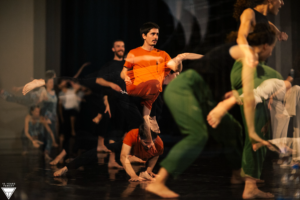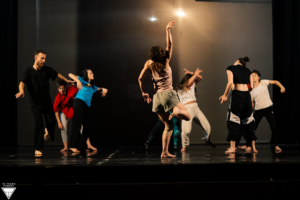By Ivana Bilić
My body is a temple, a church, a mosque, a synagogue.
An ice ball. Dripping. Slowly. Drip. Drip. Drip. The dancer lies down. Taking the droplets of water in her mouth. The ball is round, like a globe, perfect shape, but also cold, like an empty womb, barren. The artist gets up only to fall down instances later. Repetitive music notes. Repetitive robotic movements. Are we at war with our bodies? Are we at war with ourselves?
Then we hear some words. Breaking the rules of traditional dancing. There are no words in dancing. But here they are:
“People do their shit and they do what they want. And they don’t give a fuck about (no)body. There is nobody. There is no body. I have a body. My body is a temple, a church, a mosque, a synagogue. My body is the only land I own. And I can do whatever I want with my body.”
The Israeli artist, Miriam Engel, plays with a word nobody and gives it another meaning in no body. What a power in one simple word and in her body. In our internal war, there is a suffering body. In wars there are bodies that are left behind – tortured, injured, raped, killed. And yet, nobody talks about no bodies.
I used to think I don’t take shit from (no)body, but I take shit from every-body, and I put it inside my body and it’s a whole lot of shit, heavy shit and just this body.
We take a lot from other people. Their pain, sufferings, or simply bullshit. And this body sometimes can no longer take it. One spectator shared her thoughts with the choreographer and asked if her understanding was good one. But there is no good or bad understanding. Engel said that what she offered today to the audience, it’s theirs. They can take it with them. Whatever they understand is real, it’s true, it’s theirs.
I see ball, hole, soul, circle, spot, dot, point, bullet, gun, rifle, pistol, shotgun, missile, rocket, canon, nuclear bomb, fire, gas, stone, death, land, faith, God, truth, love, child, fear, black, race, color, sin, blood, body.
And then there is a transition from our own wars to global wars. Is it the war in Israel, in Ukraine or somewhere else, the places that are not in the spotlight and media headlines any longer? War is everywhere. Always. The artist knows that. She wears a red jumpsuit. Does it represent blood from injured bodies or raped women? Does it represent fighting? A scream to stop the war? There is a lot of symbolism in every word, every movement, every fall and every getting up.
I can find you, hurt you, harm you, hate you, rape you, I am war.
In the discussion following the performance “Stop the War”, that took place in the National Theater of Kosovo within the 10th edition of the FemArt Festival, Miriam Engel connected with her audience and exchanged views with spectators. She created this choreography a year ago, in May 2021 when another conflict in Israel escalated. But when the new war in Ukraine started, she went to her studio and prolonged the performance from 25 to 50 minutes. The artist says that it is very moving for her to play in Kosovo for the first time, knowing the country’s past, coming from Israel and in the context of another war raging in the European continent, not very far from here. Nevertheless, she underlines that she does not believe that art comes from pain. She works on another performance collecting people’s love stories that she would like to bring to Prishtina, perhaps on the FemArt next year!
MASTERCLASS with Miriam Engel
Miriam Engel (Israel) is a choreographer who is traveling and teaching around the world and on the seventh day of the festival she met some dancers, students of dance or simply dance lovers to pass her knowledge onto them. She admits that the learning process is never ending: “I feel like I’m discovering all the time and I’m nearing my forties.”
Walk and feel the space, observe it, and look closely. Open your mind and your bodies. Feel the floor. What is the temperature of the floor? The choreographer encouraged the participants to allow their bodies to do whatever they needed to do. Then walking becomes almost like running. Then they stop. Silence is important.
It is very necessary to continue and to explore the place with your bodies. They move in order to reach full intensity. They count together. Then they count backwards to slow the intensity down. Slowly. Then they talked about food. Learned how to accompany their movements with words.
The second day put it all together. The dancers already have choreography. With a lot of fluidity in their movements. They create a story. Miriam explains to the dancers: “I don’t know what the story is, it’s your story.” They step out of the river, soaked and then it drips from their bodies. Maybe they step on stones, maybe they fall, but then they get up. And then they do it again. They train their bodies. They challenge their bodies to go wider, to explore. They encourage each other. Applaud each other. Then at some point they joined their voices to the moves. They start screaming. One of the dancers said that she loved how she learned to accompany her movements with voices or screams and that she could express herself and connect to the audience. Another dancer could not fully participate due to her pregnancy but she observed and she said that her body danced and didn’t stay still. She applauded the other dancers who could not really follow everybody’s pace, but tried to keep up.
Overall, they all said that this Masterclass was very inspiring for them, they created energies throughout movement. Miriam thanked everyone for trusting her with their bodies and their minds. She will take what they said with her, the difference between acting and dancing, but both have very physical in it. She wanted to push them to be tired enough to really grasp fully into physicality and feel that scream that is inside them. Something very beautiful comes from physicality when you reach the moment of exhaustion; you do not stop. The body is amazing, if you cross the line of exhaustion, you can run for another hour, and as a performer you reach clarity. The choreographer Robert Nuha emphasized the importance of this workshop for dance in Kosovo. This is not just a workshop; it means much more because such occasions for our dancers and choreographers are rather rare. He thanked Miriam for teaching the participants the language and techniques she uses so that the dancers are now familiar with and will now be able to recognize it.
Ivana Bilić (Sarajevo, BiH) is an intern in Artpolis where she will conduct her research on the role of performing arts for social change. She is a translator and interpreter in English, French and Bosnian and a human rights student with special interest in women’s rights, minorities and LGBT+.





